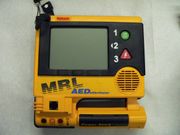From rxpgnews.com
FDA safety alerts for automated external defibrillators occur frequently
By JAMA and Archives Journals
Aug 9, 2006, 17:34
The FDA frequently issues safety advisories for automated external defibrillators (portable electronic device used to restore regular heart beat in patients with cardiac arrest) and accessories, although the number of actual device malfunctions appears to be relatively small, according to a study in the August 9 issue of JAMA.
Sudden cardiac death is a leading cause of death in the United States, accounting for nearly 330,000 deaths annually. Successful resuscitation of persons with cardiac arrest depends on prompt emergency care, with early defibrillation a key component to improved survival. The use of automated external defibrillators (AEDs) and their increasingly widespread distribution in public places, including many airports, sports arenas, and shopping centers, has resulted in the saving of innumerable lives, according to background information in the article. AEDs are easy to use, but are technically complex devices that occasionally malfunction. The U.S. Food and Drug Administration (FDA) is responsible for the safety and oversight of medical devices in the United States, and occasionally issues recalls and safety alerts (collectively referred to as "advisories"), a number of which have involved AEDs. Little is known about the reliability of AEDs.
Jignesh S. Shah, M.D., and William H. Maisel, M.D., M.P.H., of Beth Israel Deaconess Medical Center and Harvard Medical School, Boston, analyzed weekly FDA Enforcement Reports between Jan. 1996 and Dec. 2005 to identify all recalls and safety alerts involving AEDs and AED accessories. Confirmed AED device malfunctions were identified by reviewing AED-related adverse events reported to the FDA.
There were 52 advisories (4.5 per year) during the study period, affecting 385,922 AEDs and AED accessories. Automated external defibrillators were recalled in 9 of the 10 study years, and AED accessories were recalled in 7 of the 10 years studied. No year was advisory free. Overall, 21.2 percent of AEDs were affected by advisories during the study period, most often due to electrical or software problems. Every major AED manufacturer recalled products during the study period. Recalls and safety alerts more often involved AEDs than AED accessories.
"This study reassuringly demonstrates that despite increasing AED complexity, the AED advisory rate did not significantly increase during the study period. However, AED and AED accessory advisories do occur frequently. The annual number of AED advisories and the annual number of AEDs affected by advisories increased, and numerous confirmed AED malfunctions occurred during the past decade. Still, the total number of device malfunctions is small compared with the number of lives saved. Indeed, hundreds of thousands of patients underwent attempted resuscitation of ventricular arrhythmias by an AED during the study period accounting for thousands of lives saved," the authors write.
"As the prevalence of AEDs continues to increase, the number of devices affected by advisories can also be expected to increase. Efforts should be directed at developing a reliable system to locate and repair potentially defective devices in a timely fashion."
 |
In an accompanying editorial, N. A. Mark Estes III, M.D., of the New England Medical Center and Tufts University School of Medicine, Boston, comments on the findings of Drs. Shah and Maisel.
"While efforts to develop rigorous mechanisms to accurately monitor device performance will undoubtedly have costs, these efforts are essential to achieve the best possible clinical outcomes. Device manufacturers and the federal government should allocate the funds required to make this effort successful. Initial steps should be guided by knowledge that many advisory AEDs remain in service and have not been appropriately evaluated. Additional measures to accurately track those who purchase and use these devices are needed. Subsequent measures will require the best efforts of health care professionals, regulators, manufacturers, and the public working collaboratively to develop a transparent, rigorous, and systematic approach using the best practices of evidence-based medicine in postmarketing surveillance. From these efforts, guidelines for monitoring, communicating, and performance should be established. During cardiac arrest, when each minute really matters for survival, all stakeholders share the duty of ensuring the highest possible standards of AED reliability."
All rights reserved by www.rxpgnews.com
